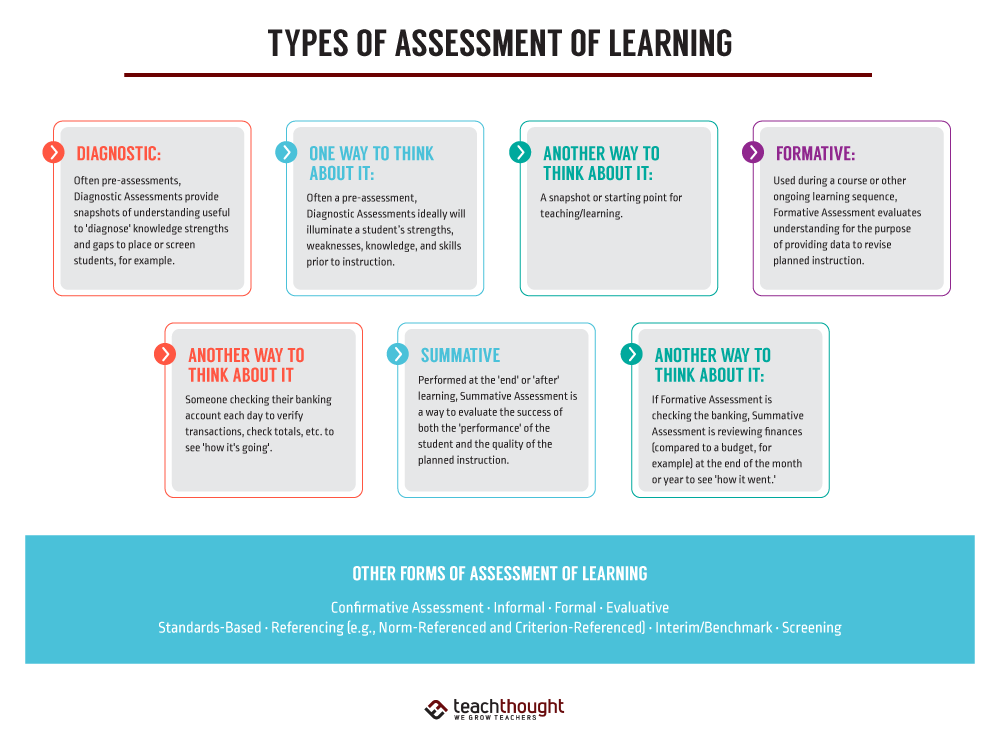
by TeachThought Staff
What are the types of assessment for learning?
And more importantly, when should you use which? If curriculum is the what of teaching and learning models are the how, assessment is the puzzled ‘Hmmmm’–as in, I assumed this and this about student learning, but after giving this assessment, well….’Hmmmmm.’
In The Difference Between Assessment Of Learning And Assessment For Learning, we explained that “assessment for learning is commonly referred to as formative assessment–that is, assessment designed to inform instruction.” Below, we identify types of assessment of learning–very briefly, with simple ways to ‘think about’ each so that you hopefully wake up with a better grasp of each type.
6 Types Of Assessment Of Learning
1. Diagnostic Assessment (as Pre-Assessment)
Diagnostic assessments are used at the beginning of a course or unit to determine students’ prior knowledge, skills, and understanding of the subject matter. This type of assessment helps teachers identify students’ strengths and weaknesses, allowing them to plan instruction that meets their students’ specific needs. Examples include pre-tests, surveys, or initial observations.
One way to think about it: Assesses a student’s strengths, weaknesses, knowledge, and skills before instruction
Another way to think about it: A baseline to work from
Tip: Done at the beginning–of the school year, beginning of a unit, beginning of a lesson, etc.
See also What Is Project-Based Learning?
2. Formative Assessment
Formative assessments are ongoing processes that teachers use to monitor student learning and provide feedback during instruction. These assessments help teachers adjust their teaching strategies to improve student understanding and performance. Examples include quizzes, class discussions, and homework assignments that inform teachers about student progress.
One way to think about it: Assesses a student’s performance during instruction, and usually occurs regularly throughout the instruction process
Another way to think about it: Like a doctor’s ‘check-up’ to provide data to revise instruction
Tip: Using digital exit ticket tools like Loop can be an easy means of checking whether students have understood lesson content, while also promoting student reflection.
3. Summative Assessment
So what are the different types of assessment of learning? The next time someone says ‘assessment,’ you can say “Which type, and what are we doing with the data?” Summative assessment, for example.
Summative assessments evaluate student learning at the end of an instructional period, such as the end of a unit, course, or school year. These assessments are used to determine if students have met the learning objectives and to assign grades. Examples include final exams, end-of-term projects, and standardized tests.
One way to think about it: Measures a student’s achievement at the end of instruction. It’s like talking to someone about a movie after the movie is over. : )
Another way to think about it: It’s macabre, but if formative assessment is the check-up, you might think of summative assessment as the autopsy. What happened? Now that it’s over, what went right and what went wrong?
Tip: Summative assessments can be useful for teachers to improve units and lessons year over year by measuring student performance because they are, in a way, as much a reflection on the quality of the units and lessons themselves as they are on the students.
4. Norm-Referenced Assessment
One way to think about it: Compares a student’s performance against other students (a national group or other ‘norm’)
Another way to think about it: Place, group or ‘demographic’ assessment. Many standardized tests are used as norm-referenced assessments.
Tip: These assessments are useful over time in student profiles or for placement in national-level programs, for example.
5. Criterion-Referenced Assessment
One way to think about it: Measures a student’s performance against a goal, specific objective, or standard
Another way to think about it: a bar to measure all students against
Tip: These can be a kind of formative assessment and should be integrated throughout your curriculum to guide the adjustment of your teaching over time. Mastery or competency-based learning would use criterion-referenced assessments.
6. Interim/Benchmark Assessment
One way to think about it: Evaluates student performance at periodic intervals, frequently at the end of a grading period. Can predict student performance on end-of-the-year summative assessments. A benchmark assessment is an interim assessment so it could be useful to think of them as distinct even though they function similarly.
Another way to think about it: Bar graph or chart growth throughout a year, often against specific ‘benchmarks’
Tip: Benchmark assessments can be useful for communicating important facts and data to parents, district officials, and others. One goal is to inform the allotment of resources (time and money) to respond to that data.
6 Types Of Assessment Of Learning
TeachThought Staff 2024-05-28 00:55:00
Source link

